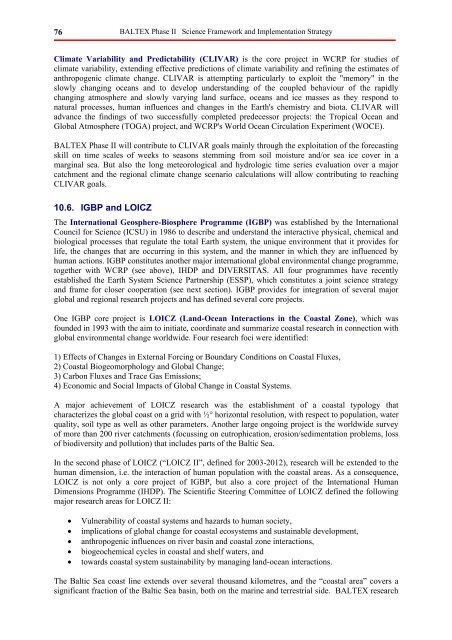BALTEX Phase II 2003 â 2012. Science Framework and ...
BALTEX Phase II 2003 â 2012. Science Framework and ...
BALTEX Phase II 2003 â 2012. Science Framework and ...
You also want an ePaper? Increase the reach of your titles
YUMPU automatically turns print PDFs into web optimized ePapers that Google loves.
76<br />
<strong>BALTEX</strong> <strong>Phase</strong> <strong>II</strong> <strong>Science</strong> <strong>Framework</strong> <strong>and</strong> Implementation Strategy<br />
Climate Variability <strong>and</strong> Predictability (CLIVAR) is the core project in WCRP for studies of<br />
climate variability, extending effective predictions of climate variability <strong>and</strong> refining the estimates of<br />
anthropogenic climate change. CLIVAR is attempting particularly to exploit the "memory" in the<br />
slowly changing oceans <strong>and</strong> to develop underst<strong>and</strong>ing of the coupled behaviour of the rapidly<br />
changing atmosphere <strong>and</strong> slowly varying l<strong>and</strong> surface, oceans <strong>and</strong> ice masses as they respond to<br />
natural processes, human influences <strong>and</strong> changes in the Earth's chemistry <strong>and</strong> biota. CLIVAR will<br />
advance the findings of two successfully completed predecessor projects: the Tropical Ocean <strong>and</strong><br />
Global Atmosphere (TOGA) project, <strong>and</strong> WCRP's World Ocean Circulation Experiment (WOCE).<br />
<strong>BALTEX</strong> <strong>Phase</strong> <strong>II</strong> will contribute to CLIVAR goals mainly through the exploitation of the forecasting<br />
skill on time scales of weeks to seasons stemming from soil moisture <strong>and</strong>/or sea ice cover in a<br />
marginal sea. But also the long meteorological <strong>and</strong> hydrologic time series evaluation over a major<br />
catchment <strong>and</strong> the regional climate change scenario calculations will allow contributing to reaching<br />
CLIVAR goals.<br />
10.6. IGBP <strong>and</strong> LOICZ<br />
The International Geosphere-Biosphere Programme (IGBP) was established by the International<br />
Council for <strong>Science</strong> (ICSU) in 1986 to describe <strong>and</strong> underst<strong>and</strong> the interactive physical, chemical <strong>and</strong><br />
biological processes that regulate the total Earth system, the unique environment that it provides for<br />
life, the changes that are occurring in this system, <strong>and</strong> the manner in which they are influenced by<br />
human actions. IGBP constitutes another major international global environmental change programme,<br />
together with WCRP (see above), IHDP <strong>and</strong> DIVERSITAS. All four programmes have recently<br />
established the Earth System <strong>Science</strong> Partnership (ESSP), which constitutes a joint science strategy<br />
<strong>and</strong> frame for closer cooperation (see next section). IGBP provides for integration of several major<br />
global <strong>and</strong> regional research projects <strong>and</strong> has defined several core projects.<br />
One IGBP core project is LOICZ (L<strong>and</strong>-Ocean Interactions in the Coastal Zone), which was<br />
founded in 1993 with the aim to initiate, coordinate <strong>and</strong> summarize coastal research in connection with<br />
global environmental change worldwide. Four research foci were identified:<br />
1) Effects of Changes in External Forcing or Boundary Conditions on Coastal Fluxes,<br />
2) Coastal Biogeomorphology <strong>and</strong> Global Change;<br />
3) Carbon Fluxes <strong>and</strong> Trace Gas Emissions;<br />
4) Economic <strong>and</strong> Social Impacts of Global Change in Coastal Systems.<br />
A major achievement of LOICZ research was the establishment of a coastal typology that<br />
characterizes the global coast on a grid with ½° horizontal resolution, with respect to population, water<br />
quality, soil type as well as other parameters. Another large ongoing project is the worldwide survey<br />
of more than 200 river catchments (focussing on eutrophication, erosion/sedimentation problems, loss<br />
of biodiversity <strong>and</strong> pollution) that includes parts of the Baltic Sea.<br />
In the second phase of LOICZ (“LOICZ <strong>II</strong>”, defined for <strong>2003</strong>-2012), research will be extended to the<br />
human dimension, i.e. the interaction of human population with the coastal areas. As a consequence,<br />
LOICZ is not only a core project of IGBP, but also a core project of the International Human<br />
Dimensions Programme (IHDP). The Scientific Steering Committee of LOICZ defined the following<br />
major research areas for LOICZ <strong>II</strong>:<br />
• Vulnerability of coastal systems <strong>and</strong> hazards to human society,<br />
• implications of global change for coastal ecosystems <strong>and</strong> sustainable development,<br />
• anthropogenic influences on river basin <strong>and</strong> coastal zone interactions,<br />
• biogeochemical cycles in coastal <strong>and</strong> shelf waters, <strong>and</strong><br />
• towards coastal system sustainability by managing l<strong>and</strong>-ocean interactions.<br />
The Baltic Sea coast line extends over several thous<strong>and</strong> kilometres, <strong>and</strong> the “coastal area” covers a<br />
significant fraction of the Baltic Sea basin, both on the marine <strong>and</strong> terrestrial side. <strong>BALTEX</strong> research













